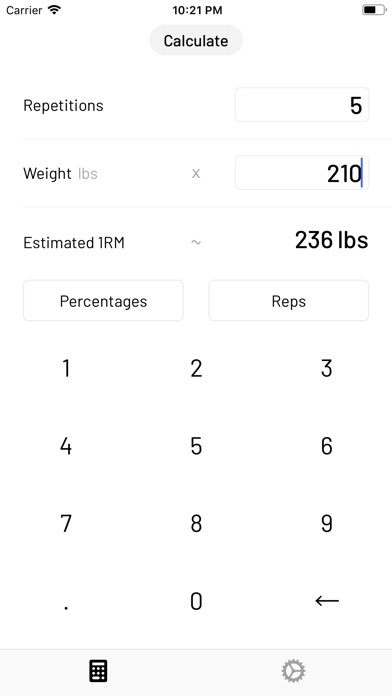
This is important to avoid injury, and to move efficiently. Plus, you’re activating muscles in the upper back and core during the movement as well.Ĭalculating a one-rep max is very important for deadlifts since you really need to focus on form (and not so much on using a heavy weight) when you first start doing this exercise. Deadlifts strengthen the glutes, hamstrings, hip flexors, and quads. The deadlift is a great strength training exercise that targets several muscle groups at once. The calculations for a one-rep max for squats are slightly less accurate as compared to bench press. Since squats can place a large amount of strain on the lower back if performed incorrectly, determining a one-rep max using a formula is a much safer way than trying to lift a heavier weight than one can handle. This movement targets the glutes, hamstrings, quads, and calves while also requiring core stabilization. One of the best weight lifting exercises to determine lower body strength is the squat. One study in particular found that formulas to calculate one-rep maxes are most accurate for bench press, as compared to deadlifts or squats. Using <10 reps at about 85% of the one-rep max appears to be the best way to estimate the one-rep max. This is also a good lift to help measure the strength of the shoulders and triceps. The bench press is the gold standard exercise to assess the strength of the chest, or pectoral muscles. By performing max reps with a lighter weight you can determine your one-rep max without an increased risk for injury. However, for trained athletes looking for maximum muscle hypertrophy, research has also shown that using heavier weights is still the best option for amplifying strength gains. By performing max reps with a lighter weight, you can determine your one-rep max while decreasing the risk of injury. Research has shown that individuals performing weight lifting sets with low reps using a heavy weight versus high reps using lighter weights have similar muscle growth. Attempting a lift with heavy weight by simply trying to “guess” your one-rep max can place an unsafe amount of stress and load on muscles, tendons, ligaments, and bones.ġRM = weight lifted × 36 / 37 – reps Max RepsĪ helpful strategy to determine your one-rep max is choosing a lighter weight and performing as many reps as you can with proper form until you fatigue. The reason for using this calculation instead of just attempting to lift a heavy weight is to avoid injuries. In this calculation, the one-rep max is based on the total number of reps lifted while using a lighter weight. One way to estimate your one-rep max is to use the Brzycki formula. It should come as no surprise that strength training has been shown to increase lean muscle mass in several studies, leading to increases in resting metabolic rate. The lean muscle gained during these workouts will increase your resting metabolic rate and allow you to burn more calories at rest.

Strength training burns calories while you exercise, and also builds lean muscle mass. From there, you can adjust your reps and sets in your strength training routine based on a percentage of your one-rep max.ĭetermining your one-rep max is important for any weightlifting program. One of the hardest things for beginners is figuring out how much weight they should be lifting for any given exercise.Ī good starting point is to determine your one-rep max, or 1RM.

In a weight lifting program, every routine consists of a certain amount of reps, sets, and weight that you lift for each exercise.


 0 kommentar(er)
0 kommentar(er)
